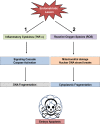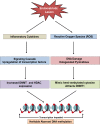Cellular and molecular basis for endometriosis-associated infertility
- PMID: 22298022
- PMCID: PMC3429772
- DOI: 10.1007/s00441-011-1309-0
Cellular and molecular basis for endometriosis-associated infertility
Abstract
Endometriosis is a gynecological disease characterized by the presence of endometrial glandular epithelial and stromal cells growing in the extra-uterine environment. The disease afflicts 10%-15% of menstruating women causing debilitating pain and infertility. Endometriosis appears to affect every part of a woman's reproductive system including ovarian function, oocyte quality, embryo development and implantation, uterine function and the endocrine system choreographing the reproductive process and results in infertility or spontaneous pregnancy loss. Current treatments are laden with menopausal-like side effects and many cause cessation or chemical alteration of the reproductive cycle, neither of which is conducive to achieving a pregnancy. However, despite the prevalence, physical and psychological tolls and health care costs, a cure for endometriosis has not yet been found. We hypothesize that endometriosis causes infertility via multifaceted mechanisms that are intricately interwoven thereby contributing to our lack of understanding of this disease process. Identifying and understanding the cellular and molecular mechanisms responsible for endometriosis-associated infertility might help unravel the confounding multiplicities of infertility and provide insights into novel therapeutic approaches and potentially curative treatments for endometriosis.
Figures




References
-
- Abae M, Glassberg M, Majercik MH, Yoshida H, Vestal R, Puett D. Immunoreactive endothelin-1 concentrations in follicular fluid of women with and without endometriosis undergoing in vitro fertilization-embryo transfer. Fertil Steril. 1994;61:1083–1087. - PubMed
-
- Abu-Musa A, Takahashi K, Kitao M. Effect of serum from patients with endometriosis on the development of mouse embryos. Gynecol Obstet Invest. 1992;33:157–160. - PubMed
-
- Agarwal A, Saleh RA, Bedaiwy MA. Role of reactive oxygen species in the pathophysiology of human reproduction. Fertil Steril. 2003;79:829–843. - PubMed
-
- Agic A, Xu H, Finas D, Banz C, Diedrich K, Hornung D. Is endometriosis associated with systemic subclinical inflammation? Gynecol Obstet Invest. 2006;62:139–147. - PubMed
Publication types
MeSH terms
Grants and funding
LinkOut - more resources
Full Text Sources
Medical

